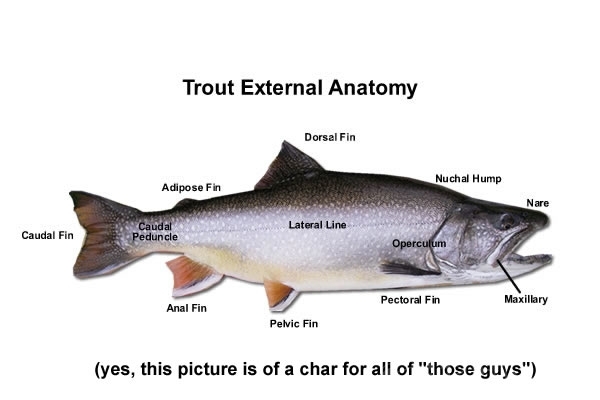Trout Anatomy: Uncovering The Number Of Limbs

Trout Anatomy: Uncovering The Number Of Limbs. Discover more detailed and exciting information on our website. Click the link below to start your adventure: Visit Best Website. Don't miss out!
Table of Contents
Trout Anatomy: Uncovering the Number of Limbs – A Deep Dive into Fish Physiology
The seemingly simple question, "How many limbs does a trout have?" opens a fascinating window into the world of fish anatomy and evolutionary biology. While the answer might appear straightforward at first glance, a closer look reveals intriguing adaptations and a nuanced understanding of locomotion in aquatic environments. This article delves into the specifics of trout anatomy, clarifying their limb structure and exploring the broader implications for their survival and behavior.
Understanding the Unique Anatomy of Trout
Trout, belonging to the Salmonidae family, are ray-finned fish, meaning their fins are supported by bony rays. Unlike terrestrial vertebrates with paired limbs (forelimbs and hindlimbs), trout possess a different, highly efficient system for movement and stability in water. Instead of limbs, trout rely on a sophisticated arrangement of fins, each with a specific function:
- Dorsal Fin: Located on the back, this fin provides stability and prevents rolling. Its size and shape can vary depending on the trout species and its habitat.
- Caudal Fin (Tail Fin): The powerful tail fin is the primary source of propulsion, generating thrust for swimming. Its shape, often forked or rounded, contributes to the trout's speed and maneuverability.
- Anal Fin: Positioned on the underside of the body, near the tail, the anal fin aids in stability and helps with steering.
- Pelvic Fins (Ventral Fins): These paired fins are located on the underside of the trout, near the gills. They are primarily used for balance and slow, controlled movements.
- Pectoral Fins: These paired fins, situated just behind the gills, assist with maneuvering, braking, and hovering. They play a crucial role in precise movements within their environment.
Why Trout Don't Have Limbs: An Evolutionary Perspective
The absence of limbs in trout is a direct consequence of their aquatic lifestyle. Millions of years of evolution have shaped their bodies to be perfectly streamlined for life in water. Limbs, while advantageous for terrestrial locomotion, would be cumbersome and inefficient for navigating aquatic environments. The fins of trout provide superior maneuverability and propulsion compared to what limbs could offer in water. Their streamlined body shape minimizes drag, allowing for efficient movement through the water column.
The Significance of Fin Structure in Trout Ecology
The structure and function of a trout's fins are intimately linked to its ecological niche. Different species of trout, inhabiting diverse environments from fast-flowing rivers to still lakes, exhibit variations in fin shape and size reflecting adaptations to their specific habitats. For instance, trout in fast-flowing rivers may have larger, more powerful caudal fins for navigating strong currents.
Debunking Common Misconceptions:
It's important to dispel any confusion: when referring to "limbs," we are discussing structures analogous to the arms and legs of terrestrial vertebrates. Trout do not possess these appendages. Their fins, while crucial for locomotion and stability, are fundamentally different structures.
Conclusion: Understanding Trout Morphology
The anatomy of trout, specifically the absence of limbs and the presence of specialized fins, provides a compelling example of evolutionary adaptation to a specific environment. Studying trout anatomy deepens our appreciation for the incredible diversity and ingenuity of the natural world. Further research into trout physiology continues to reveal new insights into the intricate adaptations of these remarkable fish. Learn more about fish anatomy and conservation efforts by visiting [link to a relevant conservation organization or resource].

Thank you for visiting our website wich cover about Trout Anatomy: Uncovering The Number Of Limbs. We hope the information provided has been useful to you. Feel free to contact us if you have any questions or need further assistance. See you next time and dont miss to bookmark.
Featured Posts
-
 Remembering The Fallen The Real Story Of Memorial Day
Feb 05, 2025
Remembering The Fallen The Real Story Of Memorial Day
Feb 05, 2025 -
 Mattheo Riddle A Critical Analysis Of His Role In The Narrative
Feb 05, 2025
Mattheo Riddle A Critical Analysis Of His Role In The Narrative
Feb 05, 2025 -
 Love Island All Stars 2025 Get To Know Samie Elishi
Feb 05, 2025
Love Island All Stars 2025 Get To Know Samie Elishi
Feb 05, 2025 -
 Revealed Mathys Tels Reasons For Joining Tottenham Hotspur
Feb 05, 2025
Revealed Mathys Tels Reasons For Joining Tottenham Hotspur
Feb 05, 2025 -
 Rape And Human Trafficking Lawsuit Filed Against Neil Gaiman And Amanda Palmer
Feb 05, 2025
Rape And Human Trafficking Lawsuit Filed Against Neil Gaiman And Amanda Palmer
Feb 05, 2025
